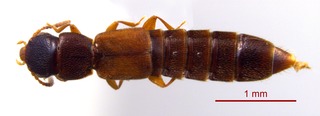
The rove beetles are a family (Staphylinidae) of beetles, primarily distinguished by their short elytra that typically leave more than half of their abdominal segments exposed. With over 66,000 species in thousands of genera, the group is the largest family in the beetle order, and one of the largest families of organisms. It is an ancient group, with fossilized rove beetles known from the Triassic, 200 million years ago, and possibly even earlier if the genus Leehermania proves to be a member of this family. They are an ecologically and morphologically diverse group of beetles, and commonly encountered in terrestrial ecosystems.

The Omaliinae are a subfamily of the Staphylinidae, rove beetles.

Pselaphinae are a subfamily of beetles in the family Staphylinidae, the rove beetles. The group was originally regarded as a separate family named Pselaphidae. Newton and Thayer (1995) placed them in the Omaliine group of the family Staphylinidae based on shared morphological characters.

Dasycerinae is a subfamily of rove beetles. Dasycerinae currently only contains 1 extant genus and 3 extinct genera.

Steninae is a subfamily of Staphylinidae.

The Aleocharinae are one of the largest subfamilies of rove beetles, containing over 12,000 species. Previously subject to large-scale debate whether the subfamily deserved the familial status, it is now considered one of the largest subfamilies of rove beetles.

The Oxytelinae are a subfamily of the Staphylinidae, rove beetles. There are about 20 genera and at least 320 described species in Oxytelinae.

Phloeocharinae Erichson 1839 are a subfamily of Staphylinidae.

Piestinae are a subfamily of Staphylinidae.

Scaphidiinae is a subfamily of Staphylinidae.
Mipseltyrus is a genus of ant-loving beetles in the family Staphylinidae. There are at least 4 described species in Mipseltyrus.

Drusilla canaliculata is a species of rove beetle in the family Staphylinidae. It is found in Europe and Northern Asia and North America.

Drusilla is a genus of rove beetles in the family Staphylinidae. There are at least 2 described species in Drusilla.

Quedius is a genus of large rove beetles in the family Staphylinidae. There are about 800 described species in Quedius.

Staphylinini is a tribe of large rove beetles in the family Staphylinidae. There are at least 20 genera and 120 described species in Staphylinini.

Platystethus is a genus of spiny-legged rove beetles in the family Staphylinidae. There are about 6 described species in Platystethus.

Athetini is a tribe of rove beetles in the family Staphylinidae. There are at least 50 genera and 430 described species in Athetini.

Bledius is a genus of spiny-legged rove beetles in the family Staphylinidae. There are at least 100 described species in Bledius.
Platyusa is a monotypic genus of rove beetles in the family Staphylinidae. There is one described species in Platyusa, P. sonomae, found in the western United States.
Goniusa is a genus of rove beetles in the family Staphylinidae. There are at least three described species in Goniusa.
















